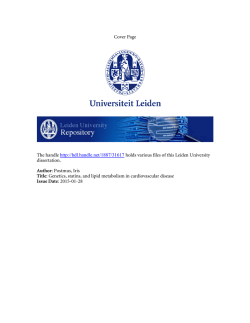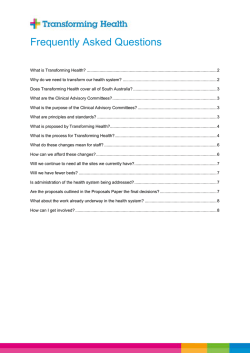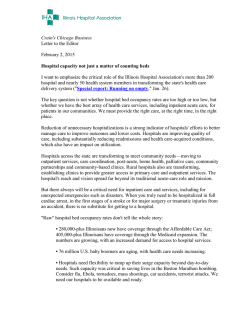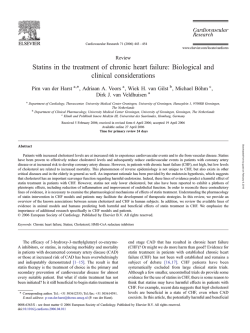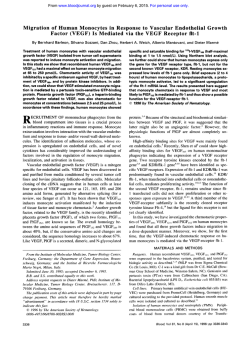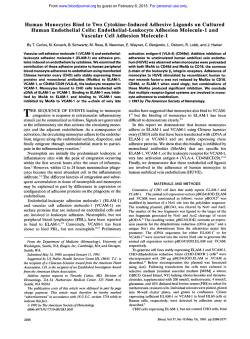
Increased Transforming Growth Factor
Journal of the American College of Cardiology © 2002 by the American College of Cardiology Foundation Published by Elsevier Science Inc. Vol. 39, No. 11, 2002 ISSN 0735-1097/02/$22.00 PII S0735-1097(02)01857-0 Increased Transforming Growth Factor-Beta1 Circulating Levels and Production in Human Monocytes After 3-Hydroxy-3-Methyl-GlutarylCoenzyme A Reductase Inhibition With Pravastatin Ettore Porreca, MD, Concetta Di Febbo, MD, Giovanna Baccante, PHD, Marcello Di Nisio, MD, Franco Cuccurullo, MD Chieti, Italy We sought to determine whether inhibition of 3-hydroxy-3-methyl-glutaryl-coenzyme A (HMG-CoA) reductase with pravastatin affects transforming growth factor-beta1 (TGFbeta1) circulating levels and its production in the monocytes of hypercholesterolemic patients. BACKGROUND Transforming growth factor-beta1 is a multifunctional growth factor/cytokine involved in many physiologic and pathologic processes, such as vascular remodeling and atherogenesis. Statins have been reported to have a modulatory role in cytokine expression in the monocytes of hyperlipidemic patients. METHODS We evaluated, in a cross-over study design, plasma TGF-beta1 levels and ex vivo TGF-beta1 production in the monocytes of hypercholesterolemic patients before and after four to six weeks of lipid-lowering treatment with diet or diet plus 40 mg/day of pravastatin. In addition, isolated blood monocytes were subjected to pravastatin treatment and evaluated for TGFbeta1 messenger ribonucleic acid (mRNA) expression and TGF-beta1 in vitro production. RESULTS Lipid-lowering treatment significantly decreased total cholesterol and low-density lipoprotein cholesterol plasma levels. Pravastatin, but not a low lipid diet, induced a significant increase in TGF-beta1 plasma levels (from 1.7 ⫾ 0.5 ng/ml to 3.1 ⫾ 1.1 ng/ml, p ⬍ 0.001) and in ex vivo monocyte production (from 1.8 ⫾ 0.8 ng/ml to 3.9 ⫾ 1.0 ng/ml, p ⬍ 0.001). The increase in TGF-beta1 levels was not related to the changes in the lipid profile observed with pravastatin. An increase of approximately twofold in TGF-beta1 production and in mRNA expression was also observed after in vitro treatment of human monocytes with pravastatin (5 M). Co-incubation with mevalonate reversed the in vitro effect of pravastatin. CONCLUSIONS 3-Hydroxy-3-methyl-glutaryl-coenzyme A reductase inhibition with pravastatin increases TGF-beta1 plasma levels, as well as monocyte production, in hypercholesterolemic patients. The mevalonate pathway plays a role in the regulation of TGF-beta1 expression in human monocytes. A possible implication in the biologic and clinical effects of statins can be suggested. (J Am Coll Cardiol 2002;39:1752–7) © 2002 by the American College of Cardiology Foundation OBJECTIVES Transforming growth factor-beta (TGF-beta) is a multifunctional growth factor peptide reported to be involved in many physiologic and pathologic processes, such as vascular remodeling and atherogenesis (1–5). Virtually every cell in the body, including epithelial, endothelial, hematopoietic and connective tissue cells, produces TGF-beta and has receptors for it (1,2). Recent studies support the role of TGF-beta in the development of human atherosclerotic lesions (6 –11) and in the relationship between atherosclerosis, coagulation and fibrinolysis (12). Physiologic levels of TGF-beta1 have been measured in the plasma of normal human subjects, and a possible endocrine role for this peptide has been suggested (13–15). Conflicting results have been found regarding circulating levels of TGF-beta1 in patients with atherosclerotic lesions. Grainger et al. (16) found a severely depressed serum concentration of TGFFrom the Department of Medicine and Aging, Atherosclerosis and Thrombosis Section, University of Chieti Medical School, Chieti, Italy. This study was financially supported by the Italian Ministry of University, Scientific and Technological Research (Fondi Ateneo per la Ricerca Scientifica). Manuscript received October 22, 2001; revised manuscript received February 27, 2002, accepted March 1, 2002. Downloaded From: http://content.onlinejacc.org/ on 02/06/2015 beta1 in patients with advanced atherosclerotic lesions, as compared with patients with normal coronary arteries. In contrast, other studies have shown increased levels of TGF-beta, with both the occurrence and severity of atherosclerotic disease (17,18). 3-Hydroxy-3-methyl-glutarylcoenzyme A (HMG-CoA) reductase inhibitors are widely used to suppress plasma low-density lipoprotein (LDL) cholesterol levels in patients with primary hypercholesterolemia and have demonstrated a benefit in the progression of atherosclerosis and in the control of cardiovascular events (19). 3-Hydroxy-3-methyl-glutaryl-coenzyme A reductase inhibitors have been used to establish the functional involvement of the mevalonate pathway in the regulation of vascular smooth muscle cell proliferation (20), endothelial function (21), leukocyte-endothelial cell adhesion (22) and mononuclear cytokine production (23,24). Although there have been many products elaborated by monocytes and macrophages, no data have been found, at this time, on the effect of HMG-CoA reductase inhibitors on TGF-beta1, despite the fact this cytokine is synthesized by these cells, which are within the major cellular sources of TGF-beta1 (1,2). JACC Vol. 39, No. 11, 2002 June 5, 2002:1752–7 Abbreviations and Acronyms AHA ⫽ American Heart Association DNA ⫽ deoxyribonucleic acid HDL ⫽ high-density lipoprotein HMG-CoA ⫽ 3-hydroxy-3-methyl-glutaryl coenzyme A LDL ⫽ low-density lipoprotein mRNA ⫽ messenger ribonucleic acid TGF-beta1 ⫽ transforming growth factor-beta1 In this study, we conducted a four- to six-week cross-over study of pravastatin (40 mg/day) and a lipid-lowering diet. Before and at the end of treatment, the lipid profile and TGF-beta1 plasma levels were measured. In addition, we evaluated the effect of lipid-lowering treatment on TGFbeta1 production and messenger ribonucleic acid (mRNA) expression in human monocytes cultures. Our results show that four to six weeks of pravastatin treatment significantly increased TGF-beta1 circulating levels and its production in the monocytes of hypercholesterolemic patients. Furthermore, pravastatin induced an increase in mRNA expression and a dose-dependent increase in TGF-beta1 production in in vitro cultures of human monocytes. It would appear, from our observations, that pravastatin has a modulatory role on the TGF-beta1 profile. METHODS Subjects and study design. A total of 18 patients were enrolled from the Department of Internal Medicine at the University of Chieti, Italy. Patients with primary hyperlipidemia, with no previous history of ischemic heart disease, were selected. Patients with secondary hyperlipidemia (i.e., hypothyroidism, nephrotic syndrome, diabetes) were excluded. Noncardiovascular conditions associated with a possible pathogenetic role for TGF-beta (i.e., malignancy, acute and chronic liver disease, connective tissue disease) were excluded after a complete medical and laboratory examination. The study had a randomized, cross-over design. Hypercholesterolemic patients were randomly allocated to receive a low-lipid dietary regimen (American Heart Association [AHA] phase 1 diet) (25) or diet plus pravastatin (40 mg) for four to six weeks, followed by four to six weeks of cross-over treatment with a three-week washout period between regimens. Follow-up clinic visits were scheduled every four to six weeks to monitor biochemical measures. The study was approved by the Ethics Committee of Chieti University, and all patients gave written, informed consent. Serum total cholesterol, triglyceride and high-density lipoprotein (HDL) cholesterol concentrations were determined by conventional enzymatic methods, whereas LDL cholesterol was calculated by using the Friedewald formula (26). TGF-beta1 plasma assay. Drawing blood and preparing plasma were designed to minimize platelet degranulation (27). A TGF-beta1 specific enzyme-linked immunosorbent Downloaded From: http://content.onlinejacc.org/ on 02/06/2015 Porreca et al. HMG-CoA Reductase Inhibition and TGF-Beta1 1753 assay (R & D Systems Europe, Ltd., Abington, UK) was then used to quantify TGF-beta1 according to the manufacturer’s instructions. This assay detects all forms of TGFbeta1, which can be activated by treatment with acid and urea, including lipoprotein-associated TGF-beta1 (28). The sensitivity of this assay was 32 pg/ml; the intra-assay and inter-assay coefficient of variation were 5.3% and 8.8%, respectively. Mink-lung epithelial cell deoxyribonucleic acid (DNA) synthesis bioassay. Plasma levels and monocyte production of TGF-beta1 were also quantified by using an assay measuring the inhibition of the growth of CCL-64 minklung epithelial cells (ATCC, Rockville, Maryland), as previously described (29). Briefly, CCL-64 cells were plated in Dulbecco’s modified Eagle’s medium (4 ⫻ 104 cells/ml), and aliquots of acid-activated plasma samples, a conditioned medium of cultures of peripheral blood monocytes and standards of known concentrations of purified platelet human TGF-beta1 were added in triplicate to the monolayers. Synthesis of DNA was determined by pulsing with 0.5 Ci of 3H-thymidine (2 Ci/ml; Amersham Pharmacia Biotech, Cologno Monzese, Michigan) for an additional 4 h. The TGF-beta1 concentration was determined at a linear portion of the standard curve. Isolation of blood monocytes and cell cultures and TGF-beta1 expression and production. Peripheral blood monocytes of hypercholesterolemic patients were isolated, and TGF-beta1 mRNA and the protein secretion rate from these cells were studied. Peripheral heparinized blood was diluted 1:1 with normal saline, and mononuclear cells were separated by the Ficoll-Hypaque gradient, as previously described (29). Mononuclear cells recovered at the interface were seeded into Petri dishes, and then adherent monocytes (1 ⫻ 106 cells/ml) were incubated at 37°C in a 5% CO2-humidified atmosphere for 24 h in Roswell Park Memorial Institute with 1% fetal calf serum without and in the presence of pravastatin alone (1 to 10 M) and pravastatin plus mevalonate (100 M). After an incubation time of 24 h, monocyte supernatants were harvested and kept at ⫺20°C until use. Northern blot analysis. Ribonucleic acid was purified from cultured adherent monocytes by a modification of the guanidine hydrochloride extraction method (30). Total RNA was fractionated on 1% formaldehyde agarose gel, transferred to nylon membranes and hybridized according to the standard procedure. The probe used was a human TGF-beta1 isoform (gift of Dr. M. L. McGeidy, Laboratory of Tumor Immunology and Biology, National Cancer Institute, Bethesda, Maryland). The size of the transcript was indicated as relative to 18S and 28S ribosomal RNA, which were assumed to be 1.8 kb and 5.4 kb, respectively. A densitometer (Ultrascan XL, Pharmacia, Uppsala, Sweden) was used for normalization. The autoradiograms were scanned, and peak areas were measured for relative mRNA levels (TGF-beta1 mRNA/glyceraldehyde-3phosphate dehydrogenase) in the samples tested. 1754 Porreca et al. HMG-CoA Reductase Inhibition and TGF-Beta1 JACC Vol. 39, No. 11, 2002 June 5, 2002:1752–7 Table 1. Effect of Lipid-Lowering Treatment on Lipid Profile Randomized Treatment Total cholesterol (mg/dl) LDL cholesterol (mg/dl) HDL cholesterol (mg/dl) Triglycerides (mg/dl) Baseline Diet Diet Plus Pravastatin 263 ⫾ 21 175 ⫾ 25 52 ⫾ 11 149 ⫾ 38 234 ⫾ 22* 155 ⫾ 18* 52 ⫾ 11 148 ⫾ 43 206 ⫾ 17† 127 ⫾ 25†‡ 55 ⫾ 12 129 ⫾ 25 *p ⬍ 0.01 and †p ⬍ 0.001 compared with baseline. ‡p ⬍ 0.01 for pravastatin versus diet treatment. Data are expressed as the mean value ⫾ SD. HDL and LDL ⫽ high- and low-density lipoprotein, respectively. Statistical analysis. After testing the data for normality, we used the Student paired t test to compare biochemical values at baseline and after each treatment. The baseline value after the washout period was not different from the first baseline value, and no carryover effect was present after each treatment. Multivariate analysis of variance adjusted for age, gender and changes in lipids as co-variates was performed to evaluate TGF-beta1 changes after treatment. The correlation between TGF-beta1 plasma levels and other biochemical variables was assessed by the Pearson correlation test. A comparison between ex vivo TGF-beta1 production in monocytes was made using the nonparametric Mann-Whitney U test. All in vitro experiments were conducted in triplicate, with individual preparations of monocytes. Comparisons among in vitro treatment conditions were carried out by analysis of variance, followed by Dunnett’s test. The results are expressed as the mean value ⫾ SD. Statistical significance was set at p ⬍ 0.05. All computations were carried out using the SAS statistical package (SAS Institute, Cary, North Carolina) (31). Figure 1. Scatterplot showing transforming growth factor-beta1 (TGFbeta1) plasma levels in hypercholesterolemic patients (n ⫽ 18) before treatment (baseline) and after diet plus pravastatin (40 mg/day) or diet alone for four to six weeks. cpm/well, which was 3.9 ⫾ 1.0 ng/ml on the standard curve). Univariate analysis showed, at baseline, no significant correlation between TGF-beta1 levels, total cholesterol and LDL cholesterol (Fig. 2). No significant association was also found between TGF-beta1 levels, triglyceride levels (r ⫽ ⫺0.31, p ⫽ 0.19) and HDL cholesterol levels (r ⫽ ⫺0.17, p ⫽0.47). On multivariate analysis of variance, with age, gender and RESULTS The salient characteristics of the participants in this study are as follows: age, 59 ⫾ 11 years; male/female ratio, 7/11; and body mass index, 24.5 ⫾ 3 kg/m2. As shown in the Table 1, there was a significant reduction in total and LDL cholesterol with diet and diet plus pravastatin treatment. There were no significant effects on triglyceride and HDL cholesterol levels. As shown in Figure 1, pravastatin treatment resulted in a significant increase in TGF-beta1 levels (1.7 ⫾ 0.5 ng/ml to 3.1 ⫾ 1.1 ng/ml, p ⬍ 0.001). There were no significant differences in the mean values of TGF-beta1 from baseline to the end of treatment in the patients treated only with diet (1.7 ⫾ 0.5 ng/ml to 1.6 ⫾ 0.7 ng/ml, p ⫽ 0.8). The TGF-beta1– dependent biologic activity was also tested using the mink-lung cells growth inhibition bioassay, which showed that plasma samples from hypercholesterolemic patients inhibited DNA synthesis to 48 ⫾ 8% of the control values (CCL-64 cells in the conditioned medium) (6,400 to 3,100 cpm/well, which was 1.8 ⫾ 0.8 ng/ml on the standard curve); the plasma samples of patients treated with pravastatin showed an increased TGF-beta1– dependent inhibitory activity, which came close to 11.0 ⫾ 0.9% of the control values (6,400 to 700 Downloaded From: http://content.onlinejacc.org/ on 02/06/2015 Figure 2. Scatterplots showing the relationships between transforming growth factor-beta1 (TGF-beta1) plasma levels and low-density lipoprotein (LDL) (top) and total cholesterol (bottom) levels in hypercholesterolemic patients (n ⫽ 18). JACC Vol. 39, No. 11, 2002 June 5, 2002:1752–7 Porreca et al. HMG-CoA Reductase Inhibition and TGF-Beta1 1755 incubation of pravastatin (5 M) with mevalonate (100 M) reversed the increase in TGF-beta1 production induced by pravastatin (Fig. 4A). Figure 4B is a representative Northern blot analysis of TGF-beta1 mRNA expression from human monocyte cultures with or without pravastatin (5 M). Significant pravastatin-induced TGF-beta1 mRNA expression was observed after 24 h of incubation time; this increase was prevented by 100 M of mevalonate. A 2.3-fold mean increase was found after densitometric analysis of three consecutive experiments. Figure 3. Production of transforming growth factor-beta1 (TGF-beta1) in the monocytes of hypercholesterolemic patients (n ⫽ 9) at baseline and after four to six weeks of diet plus pravastatin (40 mg/day) treatment. A conditioned medium of unstimulated cultures was collected after 24 h, and the biologic activity of TGF-beta1 was evaluated after acidification for mink-lung epithelial cell bioassay. Mink-lung cells respond to TGF-beta1 released in the culture medium, with a decrease in deoxyribonucleic acid synthesis, as evaluated by 3H-thymidine incorporation. A comparison with the standard curve and multiplication by the dilution factor (1:10) yielded TGF-beta1 concentration (ng/ml) in the conditioned medium of monocyte cultures. the magnitude of change in total cholesterol, LDL cholesterol, triglyceride and HDL cholesterol levels as co-variates, TGF-beta1 levels were still significantly increased by pravastatin (p ⬍ 0.0001), but not by diet (p ⫽ 0.50; difference between therapies: p ⫽ 0.0006). In the total cohort, no significant correlation was observed between the magnitude of changes in TGF-beta1 levels and the magnitude of changes in total and LDL cholesterol after pravastatin treatment (r ⫽ 0.18, p ⫽ 0.45 and r ⫽ 0.87, p ⫽ 0.72, respectively), and this confirms that the increase in TGF-beta1 levels after pravastatin therapy was independent of lipids changes. Moreover, in a subgroup of nine patients, we evaluated whether four to six weeks of lipid-lowering treatment with diet and pravastatin was also effective on TGF-beta1 production in the monocytes of hypercholesterolemic patients. Figure 3 reports, for each patient, an individual change in TGF-beta1 production in the monocytes of hypercholesterolemic patients before and after lipid-lowering treatment, as evaluated by the mink-lung cells growth inhibition bioassay. We found a 2.4-fold mean increase in TGF-beta1– dependent biologic activity after pravastatin treatment, as compared with the baseline values (at baseline: 3Hthymidine incorporation: 4,400 ⫾ 500 cpm/well, which was 1.6 ⫾ 0.2 ng/ml on the standard curve; after pravastatin: 1,790 ⫾ 400 cpm/well, which was 3.8 ⫾ 0.9 ng/ml on the standard curve; p ⬍ 0.01). To elucidate the possible mechanisms for changes in monocyte TGF-beta1 production, we studied the effect of pravastatin on in vitro TGF-beta1 production in monocytes and its mRNA expression. Treatment with pravastatin dose-dependently increases TGF-beta1 production from 4.5 ⫾ 1.0 to 9.5 ⫾ 3 ng/ml at 5 M (p ⬍ 0.01, n ⫽ 5). No further significant increase was observed at 10 M. Co- Downloaded From: http://content.onlinejacc.org/ on 02/06/2015 DISCUSSION Lipid-lowering therapy for cardiovascular disease is common, and all of the mechanisms responsible for the benefit of statins remain to be defined (19). Our study focused on the impact of statin therapy on the levels of TGF-beta1, a growth factor/cytokine implicated in the regulation of chronic inflammation and atherogenesis (2). Our study shows that four to six weeks of lipid-lowering treatment with pravastatin (40 mg/day) significantly increased TGFbeta1 circulating levels, as compared with lipid-lowering treatment with the AHA phase 1 diet. Ex vivo monocyte production of TGF-beta1 was also increased after pravastatin treatment. Finally, pravastatin induced a dosedependent increase in TGF-beta1 production and a significant increase in mRNA expression in in vitro cultures of human monocytes. Thus, taken together, our observations demonstrate a pravastatin-dependent upregulation of the TGF-beta1 profile. Comparison with previous studies. Knowledge of the effect of statin treatment on TGF-beta1 expression is limited. Contrasting results have been found in TGF-beta1 tissue expression after HMG-CoA reductase inhibitor treatment. Kitahara et al. (32) demonstrated that HMGCoA reductase inhibition, which was able to suppress balloon injury-induced neointimal thickening, was associated with an increase in vascular TGF-beta expression. In contrast, other studies demonstrated that statins were able to inhibit TGF-beta1 expression in diabetic rat glomeruli and cultured rat mesangial cells (33,34). Park and Galper (35) recently demonstrated, in embrionic chicken atrial cells, in the absence of lipoproteins, that inhibition of the cholesterol pathway by HMG-CoA reductase inhibitors resulted in a coordinated upregulation of the expression of TGF-beta1, its type II receptor and plasminogen activator inhibitor-1 promoter activity (35). These findings seem to be cell-type specific and associated with different in vitro and animal experimental conditions. Our data extend these findings by demonstrating the effect of a HMG-CoA reductase inhibition on TGF-beta1 levels in hypercholesterolemic patients and in in vitro human monocytes. According to several other studies, the beneficial effects of statins may not be related to their cholesterol-lowering actions (36). We found that the magnitude of increase in 1756 Porreca et al. HMG-CoA Reductase Inhibition and TGF-Beta1 Figure 4. The effect of pravastatin (Prava) and mevalonate (MEV) on the production and messenger ribonucleic acid (mRNA) levels of transforming growth factor-beta1 (TGF-beta1). (A) Bioassay of TGF-beta1 activity in a conditioned medium of monocyte cultures incubated with pravastatin (1–10 M) or pravastatin (5 M) plus mevalonate (100 M). A conditioned medium from the cultures was collected after 24 h and acidified for mink-lung epithelial cell bioassay. Mink-lung cells respond to TGF-beta1 released in the culture medium, with a dose-dependent decrease in deoxyribonucleic acid (DNA) synthesis, as evaluated by 3H-thymidine incorporation. A comparison with the standard curve and multiplication by the dilution factor (1:10) yielded a dose-dependent increase in the TGF-beta1 concentration (ng/ml) in the conditioned medium of monocyte cultures. Mevalonate reversed the TGF-beta1– dependent effect on minklung cells. The results are expressed as the mean value ⫾ SD of three independent experiments performed in triplicate. Comparisons among treatment conditions were carried out by analysis of variance, followed by Dunnett’s test. *p ⬍ 0.05, **p ⬍ 0.01 and p ⫽ NS versus untreated (control) cells. (B) Representative Northern blot analysis of TGF-beta1 and glyceraldehyde-3-phosphate dehydrogenase (GAPDH) mRNA in human peripheral blood monocytes after incubation with pravastatin (5 M) alone or mevalonate (100 M) together with pravastatin (5 M). Mononuclear cells were cultured 24 h in serum-free conditions. Total RNA (5 g per lane) was electrophoresed on 1.5% formaldehyde agarose gels, transferred to nitrocellulose and hybridized with 32P random primer-labeled TGFbeta1 complementary DNA. The sizes of the transcripts were determined by comparison with 28S and 18S ribosomal RNA. Molecular size markers are shown on the left. Lane 1 ⫽ untreated cells; lane 2 ⫽ pravastatintreated cells; and lane 3 ⫽ cell treated with pravastatin plus mevalonate. Quantitative data obtained from imaging are expressed in arbitrary units. Downloaded From: http://content.onlinejacc.org/ on 02/06/2015 JACC Vol. 39, No. 11, 2002 June 5, 2002:1752–7 TGF-beta1 circulating levels observed after pravastatin did not show any correlation with the magnitude of change in total and LDL cholesterol levels. Furthermore, after adjustment for age, gender and changes of lipid levels, TGF-beta1 concentrations were still significantly increased by pravastatin, but not by diet alone. HMG-CoA reductase inhibition and TGF-beta1. The involvement of the melavonate pathway in the upregulation of TGF-beta1 expression in human monocytes was demonstrated by prevention of the stimulatory effect caused by pravastatin, when mevalonate was simultaneously added to pravastatin in the culture medium. We did not undertake further studies to evaluate different branches of the cholesterol metabolic pathway (37); however, previous studies demonstrated that HMG-CoA reductase inhibitors may upregulate TGF-beta signaling through a geranylgeranylation pathway (35). The finding that HMG-CoA reductase inhibition is able to induce an increase in the monocyte expression of TGFbeta1 could have important implications for the mechanism of action of these agents. TGF-beta1 showed a wide range of activities on vascular and inflammatory cells, and may have different functions during various stages of atherosclerosis. In vitro and in vivo experimental studies demonstrated a role of TGF-beta1 in vascular smooth muscle cell proliferation, extracellular matrix synthesis and myointimal hyperplasia (38 – 41). Recent studies demonstrated, in mice heterozygous for the deletion of the TGF-beta1 gene, subjected to a cholesterol-enriched diet, a significant inflammatory response in the vascular wall, as compared with normal mice, suggesting a TGF-beta1– dependent anti-inflammatory role in the pathogenesis of vascular lipid inflammatory lesions (42). In addition, in vitro studies showed a role of TGFbeta1 in the control of LDL receptor expression on human liver and vascular smooth muscle cells (43,44). Our data cannot suggest any pathophysiologic implications for TGFbeta1 upregulation induced by pravastatin. However, because some studies reported depressed, active TGF-beta1 levels among patients with advanced atherosclerosis (16,18), and others demonstrated that a genetically induced deficiency of TGF-beta1 in mice promotes atherosclerosis (42), a possible beneficial contribution of the statin-dependent TGF-beta1 increase could be suggested. Conclusions. An increase in TGF-beta1 plasma levels and monocyte production by lipid-lowering treatment with an HMG-CoA reductase inhibitor is a novel biologic effect of these compounds, which should be kept in mind to explain their pharmacologic action. Our results seem to show that the increase in TGF-beta1 is due to interference with the mevalonic pathway, not related to a cholesterol-lowering effect. Additional studies are necessary to clarify the pathophysiologic consequences of TGF-beta pathway activation after pravastatin treatment. JACC Vol. 39, No. 11, 2002 June 5, 2002:1752–7 Acknowledgments We are grateful to Dr. Augusto Di Castelnuovo for his statistical advice and Alessandro Piccirelli for his technical assistance. Reprint requests and correspondence: Prof. Ettore Porreca, Universita G. D’annunzio, Facolta di Medicina e Chirurgia, Centro Servizi Biomedici (SEBI), Via dei Vestini, 66013, Chieti, Italy. E-mail: [email protected]. REFERENCES 1. Sporn MB, Roberts AB. Transforming growth factor-beta: recent progress and new challenge. J Cell Biol 1992;119:1017–21. 2. Blobe GC, Schiemann WP, Lodish HF. Role of transforming growth factor-beta in human disease. N Engl J Med 2000;342:1350 –8. 3. Ross R. The pathogenesis of atherosclerosis: a perspective for 1990s. Nature 1993;362:801–9. 4. Gibbons GH, Dzau VJ. The emerging concept of vascular remodeling. N Engl J Med 1994;330:1431–8. 5. Ross R. Atherosclerosis: an inflammatory disease. N Engl J Med 1999;340:115–26. 6. McCaffrey TA, Consigli S, Du B, et al. Decreased type II/type I TGF-beta receptor ratio in cells derived from human atherosclerotic lesions: conversion from an antiproliferative to profibrotic response to TGF-beta1. J Clin Invest 1995;96:2667–75. 7. O’Brien ER, Bennett KL, Garvin MR, et al. Big-h3, a transforming growth factor-beta–inducible gene, is overexpressed in atherosclerotic and restenotic human vascular lesions. Arterioscler Thromb Vasc Biol 1996;16:576 –84. 8. Bobik A, Agrotis A, Kanellakis P, et al. Distinct patterns of transforming growth factor-beta isoform and receptor expression in human atherosclerotic lesions: colocalization implicates TGF-beta in fibrofatty lesion development. Circulation 1999;99:2883–91. 9. Frostegard J, Ulfgren AK, Nyberg P, et al. Cytokine expression in advanced human atherosclerotic plaques: dominance of proinflammatory (Th1) and macrophage-stimulating citokines. Atherosclerosis 1999;145:33–43. 10. Majesky MW, Lindner V, Twardzik DR, Schwartz SM, Reidy MA. Production of transforming growth factor-beta1 during repair of arterial injury. J Clin Invest 1991;88:904 –10. 11. Nikol S, Isner JM, Pickering JG, Kearney M, Leclerc G, Weir L. Expression of transforming growth factor-beta1 is increased in human vascular restenosis lesions. J Clin Invest 1992;90:1582–92. 12. Sueishi K, Ichikawa K, Kato K, Nakagawa K, Chen Y-X. Atherosclerosis: coagulation and fibrinolysis. Semin Thromb Hemost 1998;24: 255–60. 13. Grainger DJ, Mosedale DE, Metcalfe JC, Weissberg PL, Kemp PR. Active and acid-activatable TGF-beta in human sera, platelets and plasma. Clin Chim Acta 1995;235:11–31. 14. Wakefield LM, Letterio JJ, Chen T, et al. Transforming growth factor-beta1 circulates in normal human plasma and is unchanged in advanced metastatic breast cancer. Clin Cancer Res 1995;4:129 –36. 15. Kropf J, Schurek JO, Wollner A, Gressner AM. Immunological measurement of transforming growth factor-beta1 (TGF-beta1) in blood: assay development and comparison. Clin Chem 1997;43:1965– 74. 16. Grainger DJ, Kemp PR, Metcalfe JC, et al. The serum concentration of active transforming growth factor-beta is severely depressed in advanced atherosclerosis. Nat Med 1995;1:74 –9. 17. Wang XL, Liu SX, Wilcken DEL. Circulating transforming growth factor-beta1 and coronary artery disease. Cardiovasc Res 1997;34:404 – 10. 18. Erren M, Reinecke H, Junker R, et al. Systemic inflammatory parameters in patients with atherosclerosis of the coronary and peripheral arteries. Arterioscler Thromb Vasc Biol 1999;19:2355–63. 19. Vaughan CJ, Gotto AM, Basson CT. The evolving role of statins in the management of atherosclerosis. J Am Coll Cardiol 2000;35:1–10. 20. Raiteri M, Arnaboldi L, McGeady P, et al. Pharmacological control of the mevalonate pathway: effect on arterial smooth muscle cell proliferation. J Pharmacol Exp Ther 1997;281:1144 –53. Downloaded From: http://content.onlinejacc.org/ on 02/06/2015 Porreca et al. HMG-CoA Reductase Inhibition and TGF-Beta1 1757 21. Laufs U, La Fata V, Plutzky J, Liao JK. Upregulation of endothelial nitric oxide synthase by HMG-CoA reductase inhibitors. Circulation 1998;97:1129 –35. 22. Weber C, Erl W, Weber KSC, Weber PC. HMG-CoA reductase inhibitors decrease CD11b expression and CD11b-dependent adhesion of monocytes to endothelium and reduce increased adhesiveness of monocytes isolated from patients with hypercholesterolemia. J Am Coll Cardiol 1997;30:1212–7. 23. Rosenson RS, Tangney CC, Casey LC. Inhibition of proinflammatory cytokine production by pravastatin. Lancet 1999;353:983–4. 24. Ferro D, Parrotto S, Basili S, et al. Simvastatin inhibits the monocyte expression of proinflammatory cytokines in patients with hypercholesterolemia. J Am Coll Cardiol 2000;36:427–31. 25. National Cholesterol Education Program. Second Report of the Expert Panel on Detection, Evaluation, and Treatment of High Blood Cholesterol in Adults (Adult Treatment Panel II). Circulation 1994; 89:1329 –45. 26. Friedwald WT, Levy RI, Fredrickson DS. Estimation of the concentration of low-density lipoprotein cholesterol in plasma, without use of ultracentrifuge. Clin Chim Acta 1972;71:397–402. 27. Grainger DJ, Wakefield L, Bethell HW, Farndale RW, Metcalfe JC. Release and activation of platelet latent TGF-beta in blood clots during dissolution with plasmin. Nat Med 1995;1:932–7. 28. Grainger DJ, Byrne CD, Witchell CM, Metcalfe JC. Transforming growth factor-beta is sequestered into an inactive pool by lipoproteins. J Lipid Res 1997;38:2344 –52. 29. Porreca E, Di Febbo C, Mincione G, et al. Increased transforming growth factor-beta production and gene expression by peripheral blood monocytes of hypertensive patients. Hypertension 1997;30:134 –9. 30. Chomczynski P, Sacchi N. Single-step method of RNA isolation by acid guanidinium thiocyanate-phenol chloroform extraction. Anal Biochem 1987;162:156 –9. 31. SAS/STAT User Guide, version 8.1 for Windows. Cary, NC: SAS Institute Inc., 1989. 32. Kitahara M, Kanaki T, Toyoda K, et al. KK-104, a newly developed HMG-CoA reductase inhibitor, suppresses neointimal thickening by inhibiting smooth muscle cell growth and fibronection production in balloon-injured rabbit carotid artery. Jpn J Pharmacol 1998;77:117–28. 33. Han DC, Kim JH, Cha MK, Song KI, Hwang SD, Lee HB. Effect of HMG-CoA reductase inhibition on TGF-beta1 mRNA expression in diabetic rat glomeruli. Kidney Int 1995;51 SupplS:61–5. 34. Kim SI, Han DC, Lee HB. Lovastatin inhibits transforming growth factor-beta1 expression in diabetic rat glomeruli and cultured rat mesangial cells. J Am Soc Nephrol 2000;11:80 –7. 35. Park HJ, Galper BJ. 3-Hydroxy-3-methylglutaryl CoA reductase inhibitors upregulate transforming growth factor-beta signaling in cultured heart cells via inhibition of geranylgeranylation of RhoA GTPase. Proc Natl Acad Sci U S A 1999;96:11525–30. 36. Vaughan CJ, Murphy MB, Buckley BM. Statins do more than just lower cholesterol. Lancet 1996;348:1079 –82. 37. Goldstein JL, Brown MS. Regulation of the mevalonate pathway. Nature 1990;343:425–30. 38. Majack RA. Beta-type transforming growth factor species’ organizational behavior in vascular smooth muscle cultures. J Cell Biol 1987;105:465–71. 39. Nabel EG, Shum L, Pompili VJ, et al. Direct transfer of transforming growth factor-beta1 gene into arteries stimulates fibrocellular hyperplasia. Proc Natl Acad Sci U S A 1993;90:10759 –63. 40. Majesky MW, Lindner V, Twardzik DR, Schwartz SM, Reidy MA. Production of transforming growth factor-beta1 during repair of arterial injury. J Clin Invest 1991;88:904 –10. 41. Wolf YG, Rasmussen LM, Ruoslahti E. Antibodies against transforming growth factor-beta1 suppress intimal hyperplasia in a rat model. J Clin Invest 1994;93:1172–8. 42. Grainger DJ, Mosedale DE, Metcalfe JC, Bottinger EP. Dietary fat and reduced levels of TGF-beta1 act synergistically to promote activation of the vascular endothelium and formation of lipid lesions. J Cell Sci 2000;113:2355–61. 43. Moorby CD, Gherardi E, Dovey L, Godliman C, Bowyer DE. Transforming growth factor-1 and interleukin-1 stimulate LDL receptor activity in HepG2 cells. Atherosclerosis 1992;97:21–8. 44. Nicholson AC, Hajjar DP. Transforming growth factor-beta upregulates low-density lipoprotein receptor-mediated cholesterol metabolism in vascular smooth muscle cells. J Biol Chem 1992;267:25982–7.
© Copyright 2026
